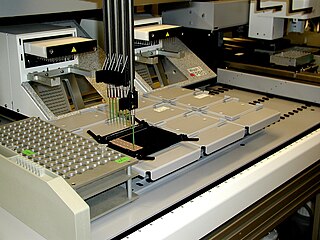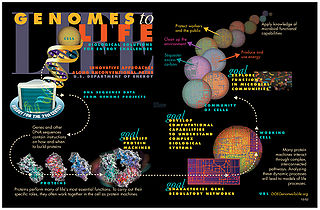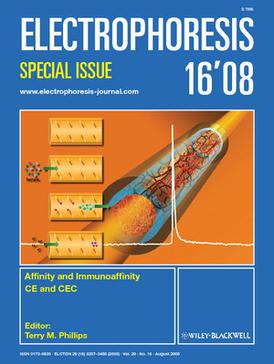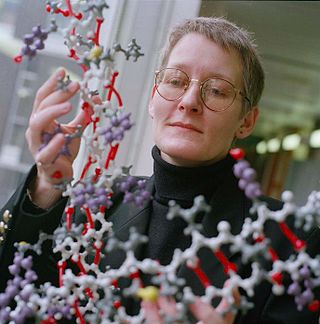
The proteome is the entire set of proteins that is, or can be, expressed by a genome, cell, tissue, or organism at a certain time. It is the set of expressed proteins in a given type of cell or organism, at a given time, under defined conditions. Proteomics is the study of the proteome.

Proteomics is the large-scale study of proteins. Proteins are vital parts of living organisms, with many functions such as the formation of structural fibers of muscle tissue, enzymatic digestion of food, or synthesis and replication of DNA. In addition, other kinds of proteins include antibodies that protect an organism from infection, and hormones that send important signals throughout the body.

The western blot, or western blotting, is a widely used analytical technique in molecular biology and immunogenetics to detect specific proteins in a sample of tissue homogenate or extract. Besides detecting the proteins, this technique is also utilized to visualize, distinguish, and quantify the different proteins in a complicated protein combination.

Systems biology is the computational and mathematical analysis and modeling of complex biological systems. It is a biology-based interdisciplinary field of study that focuses on complex interactions within biological systems, using a holistic approach to biological research.
The Association of Biomolecular Resource Facilities (ABRF) is dedicated to advancing core and research biotechnology laboratories through research, communication, and education. ABRF members include over 2000 scientists representing 340 different core laboratories in 41 countries, including those in industry, government, academic and research institutions.

Matthias Mann is a scientist in the area of mass spectrometry and proteomics.
The Journal of Labelled Compounds and Radiopharmaceuticals is a peer-reviewed scientific journal that was established in 1965. It is published in fourteen issues per year by John Wiley & Sons on behalf of the International Isotope Society and covers all aspects of research and development leading to and resulting in labelled compound preparation. The current editor-in-chiefs are R F Dannals and V Derdau.

Electrophoresis is a peer-reviewed scientific journal covering all aspects of electrophoresis, including new or improved analytical and preparative methods, development of theory, and innovative applications of electrophoretic methods in the study of proteins, nucleic acids, and other compounds.
Shotgun proteomics refers to the use of bottom-up proteomics techniques in identifying proteins in complex mixtures using a combination of high performance liquid chromatography combined with mass spectrometry. The name is derived from shotgun sequencing of DNA which is itself named after the rapidly expanding, quasi-random firing pattern of a shotgun. The most common method of shotgun proteomics starts with the proteins in the mixture being digested and the resulting peptides are separated by liquid chromatography. Tandem mass spectrometry is then used to identify the peptides.

Quantitative proteomics is an analytical chemistry technique for determining the amount of proteins in a sample. The methods for protein identification are identical to those used in general proteomics, but include quantification as an additional dimension. Rather than just providing lists of proteins identified in a certain sample, quantitative proteomics yields information about the physiological differences between two biological samples. For example, this approach can be used to compare samples from healthy and diseased patients. Quantitative proteomics is mainly performed by two-dimensional gel electrophoresis (2-DE), preparative one-dimensional gel electrophoresis, or mass spectrometry (MS). However, a recent developed method of quantitative dot blot (QDB) analysis is able to measure both the absolute and relative quantity of an individual proteins in the sample in high throughput format, thus open a new direction for proteomic research. In contrast to 2-DE, which requires MS for the downstream protein identification, MS technology can identify and quantify the changes.

The Journal of Proteome Research is a peer-reviewed scientific journal published since 2002 by the American Chemical Society. Its publication frequency switched from bimonthly to monthly in 2006. The current editor-in-chief is John R. Yates.

Protein Science is a peer-reviewed scientific journal covering research on the structure, function, and biochemical significance of proteins, their role in molecular and cell biology, genetics, and evolution, and their regulation and mechanisms of action. It is published by Wiley-Blackwell on behalf of The Protein Society. The 2021 impact factor of the journal is 6.725.
Marion Mckinley Bradford was an American scientist who developed and patented the Bradford protein assay, a method to quickly quantify the amount of protein in a sample. His paper describing the method is among the most cited scholarly articles of all time.
The New South Wales Systems Biology Initiative, directed by Marc Wilkins is a non-profit facility within the School of Biotechnology and Biomolecular Sciences at the University of New South Wales. Their focus is undertaking basic and applied research in the development and application of bioinformatics for genomics and proteomics.
SLAS Technology is a peer-reviewed scientific journal published by the Society for Laboratory Automation and Screening in partnership with Elsevier. The editor-in-chief is Edward Kai-Hua Chow, Ph.D.. The journal explores ways in which scientists adapt advancements in technology for scientific exploration and experimentation, especially in life sciences research and development. This includes drug-delivery; diagnostics; biomedical and molecular imaging; personalized and precision medicine; high-throughput and other laboratory automation technologies; micro/nanotechnologies; analytical, separation and quantitative techniques; synthetic chemistry and biology; informatics ; and more. The journal was published from 1996 through 2016 with the title Journal of Laboratory Automation. Its name changed in 2017 to more accurately reflect the evolution of its editorial scope.[1]

Teresa K. Attwood is a Professor of Bioinformatics in the Department of Computer Science and School of Biological Sciences at the University of Manchester and a visiting fellow at the European Bioinformatics Institute (EMBL-EBI). She held a Royal Society University Research Fellowship at University College London (UCL) from 1993 to 1999 and at the University of Manchester from 1999 to 2002.
The Journal of Proteomics is a peer-reviewed scientific journal published by Elsevier. It is the official journal of the European Proteomics Association and the editor-in-chief is Juan Calvete. It was established in 1979 as the Journal of Biochemical and Biophysical Methods, obtaining its current name in 2008. According to the Journal Citation Reports, the journal has a 2018 impact factor of 3.537.

Claire Eyers is a British biological mass spectrometrist who is professor of biological mass spectrometry at the University of Liverpool, where she heads up the Centre for Proteome Research. Her research publications list her either as Claire E Haydon or Claire E Eyers.

Archaeometry is a peer-reviewed academic journal covering archaeological science, particularly absolute dating methods, artefact studies, quantitative archaeology, remote sensing, conservation science, and environmental archaeology. It is published bimonthly by Wiley-Blackwell, on behalf of the Research Laboratory for Archaeology and the History of Art at the University of Oxford, in association with the Gesellschaft für Naturwissenschaftliche Archäologie Archäometrie and the Society for Archaeological Sciences. Its current editors are A. Mark Pollard, Ina Reiche, Brandi MacDonald, Gilberto Artioli, and Catherine Batt.












